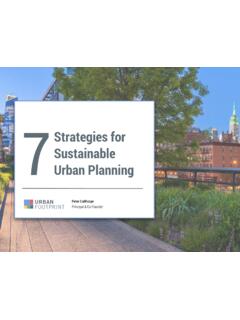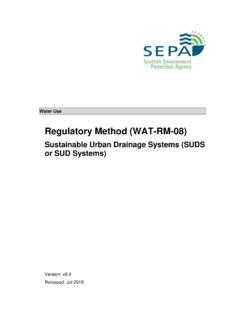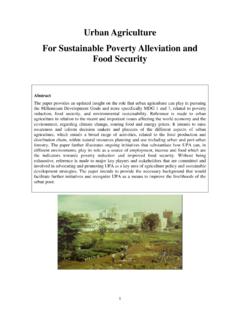Transcription of Guidance on the permeable surfacing of front gardens
1 Guidance on the permeable surfacing of front , opportunity, prosperitySeptember 2008 Department for Communities and Local GovernmentGuidance on the permeable surfacing of front gardensCommunities and Local Government Eland HouseBressenden PlaceLondon SW1E 5 DUTelephone: 020 7944 4400 Website: Crown Copyright, 2008 Copyright in the typographical arrangement rests with the publication, excluding logos, may be reproduced free of charge in any format or medium for research, private study or for internal circulation within an organisation. This is subject to it being reproduced accurately and not used in a misleading context. The material must be acknowledged as Crown copyright and the title of the publication other use of the contents of this publication would require a copyright licence. Please apply for a Click-Use Licence for core material at , or by writing to the Office of Public Sector Information, Information Policy Team, Kew, Richmond, Surrey TW9 4 DUe-mail: you require this publication in an alternative format please email and Local Government PublicationsTel: 030 0123 1124 Fax: 030 0123 1125 Email: via the Communities and Local Government website: published September 2008, revised edition May 2009 Product Code: 08 COMM 05532 ISBN: 978-1-4098-0486-4 Contents 3 ContentsSection 1 What is the problem with paving front gardens ?
2 6 Section 2 How can we prevent the problems? 7 Section 3 Types of surfaces 10 Section 4 How to design and construct permeable surfaces 16 Section 5 Looking after a permeable driveway 19 Section 6 Where can I find more information? 20 Section 7 Glossary 22 Introduction 5 Guidance on the permeable surfacing of front gardensIntroduction to the leafletFrom 1 October 2008 the permitted development rights (see Glossary) that allow householders to pave their front garden with hardstanding without planning permission have changed in order to reduce the impact of this type of development on flooding and on pollution of watercourses. You will not need planning permission if a new or replacement driveway of any size uses permeable (or porous) surfacing , such as gravel, permeable concrete block paving or porous asphalt, or if the rainwater is directed to a lawn or border to drain naturally. If the surface to be covered is more than five square metres planning permission will be needed for laying traditional, impermeable driveways that do not provide for the water to run to a permeable for planning permission will require you to fill in an application form, draw plans (which have to be to scale) and pay a fee of 150.
3 Planning applications for this type of householder development should normally be decided within 8 weeks after leaflet explains the different approaches to constructing a driveway or other paved area that controls and reduces rainfall runoff into drains by using permeable surfaces or soakaways and rain gardens (a small planted depression designed to manage rainwater see Glossary). The advice can also be applied to other paved areas around the house, such as Guidance has six main sections:1. What is the problem with paving front gardens ?2. How can we prevent the problems?3. Types of surfaces4. How to design and construct permeable surfaces5. Looking after a permeable driveway6. Where can I find more information?7. Glossary6 Guidance on paving front gardensSection 1 What is the problem with paving front gardens ?Serious flooding in 2007 affected the UK. This resulted in loss of life, disruption of peoples lives and caused damage estimated at about 3bn. In many cases the flooding happened because drains could not cope with the amount of rain water flowing to them.
4 The effects of climate change mean that this kind of heavy rainfall event (and subsequent flooding) may occur more often in the drains in most urban areas were built many years ago and were not designed to cope with increased rainfall. Paving front gardens further adds to the problem. Although paving over one or two gardens may not seem to make a difference, the combined effect of lots of people in a street or area doing this can increase the risk of harm caused by paving gardens is not limited to just flooding. Hard surfaces such as concrete and asphalt collect pollution (oil, petrol, brake dust etc) that is washed off into the drains. Many drains carry rainwater directly to streams or rivers where the pollution damages wildlife and the wider environment. In older areas the rainwater may go into the foul water sewer which normally takes household waste from bathrooms and kitchens to the sewage treatment works. These overflow into streams and rivers in heavy rainfall. As more water runs into foul sewers from paved areas there are more frequent overflows, passing untreated sewage into grass and plant beds with concrete and asphalt surfaces means that water does not soak into the ground.
5 This reduces the amount that reaches our natural underground aquifers. Some water that soaks into the ground will evaporate back into the air, causing a cooling effect around the house. This is lost if the garden is covered with hard impermeable surfaces and can cause local temperatures to rise (often referred to as the urban heat island effect).Section 2 How can we prevent the problem? 7 Section 2 How can we prevent the problem?You can provide paved areas in front of your house without adding to flood risk and pollution. You can use permeable surfaces that allow water to drain into them or by other methods such as rain gardens (see below). permeable driveways are often more attractive than an expanse of concrete, adding value to the property. These types of surfaces can also be better for the environment and do not necessarily cost more or require a lot of are three main types of solution to creating a permeable driveway: Using gravel or a mainly green, vegetated area.
6 Directing water from an impermeable surface to a border rain garden or soakaway. Using permeable block paving, porous asphalt or can also combine the methods in a single garden to get an interesting appearance (A Royal Horticultural Society leaflet and their website give more information See Section 6). The most appropriate construction will depend on factors such as the space available, slopes, the type of soil and whether the existing garden gets do they work?Modern permeable surfaces work by allowing water to soak through the surface into the ground below. Soakaways can be located along the edges of impermeable driveways or in the garden area to collect water and allow it to soak into the ground. On clay soils it may be necessary to connect to the house roof water modern vs old style impermeable driveways8 Guidance on paving front gardensPermeable and impermeable surfaces after rainfallThe materials used in permeable construction are different to those used in impermeable driveway construction.
7 Both types of surface have a sub-base layer used to make the ground strong enough to carry cars without surfaced driveways use a sub-base material called hardcore or a material called MOT Type 1 by contractors. This has a lot of fine material in it (sand and silt) that stops water passing through it easily. For permeable and porous driveways different materials are required that allow water to pass through and also store the water for a while if it cannot soak into the ground as fast as the rain falls. Various materials are available and two examples are known as 4/20 and Type 3 sub-base. These materials are described as open graded and consist only of larger pieces of stone that have space between to store water. The material used will depend on the permeable or porous system being constructed. If the rainwater is draining to a raingarden or soakaway the driveway construction can use traditional impermeable materials. The open graded materials must still be compacted in the same way as normal sub-base to provide a firm foundation for the driveway, but will have voids between the pieces of surface (porous asphalt) is dryImpermeable surface has puddlesSection 2 How can we prevent the problem?
8 9 permeable subbase (4/20 material)Impermeable hardcore or Type 1A bucket of water poured onto the permeable sub-base on the left will soak in straight away in a small area. It will take longer for water to soak into compacted impermeable hardcore or Type 1 and it will spread over a wider are the options?Water from a paved surface can be dealt with using three main approaches: Soaking into ground (soakaway) Rainwater harvesting (see Glossary) or storage for later use Flowing to the drains, but this should be the last option considered and might not be permitted developmentA combination of systems can also be used, where water soaks into the ground but there is also an overflow connection to the drains for periods of really heavy and extended rainfall. This is useful if the soils are clayey and do not drain very well. Rainwater harvesting systems will usually have an overflow to a soakaway or the new driveway is small, if the existing garden is not water logged it should be acceptable to allow the water to soak into the ground.
9 If the garden is already waterlogged the sub-base below the driveway will need to be drained by connecting a pipe from within the sub-base to the Guidance on paving front gardensSection 3 Types of surfacePlanted and gravel drivewaysThe Royal Horticultural Society has identified many simple ways that a green or gravel driveway can be created. These green solutions provide an attractive space that can be used to park gravelThis is the most simple type of construction. The driveway sub-base is covered by a surface layer of gravel or shingle. Gravel with different shapes and colours is available to make the surface more decorative. A strip of block paving or asphalt at the entrance can limit the loss and spread of gravel from the drive. Pros ConsSimple to construct and maintainGravel will scatter or form wavesCheapNot suitable on steeply sloping drivesMaterials readily availableNot suitable for wheel-chairsEasily integrated with planting to provide visual enhancement to driveway layoutSection 3 Types of surface 11 Wheel tracksTo keep hard surfaces to a minimum a driveway can be created that has just two paved tracks where the wheels go.
10 These can be surfaced with blocks, asphalt or concrete, but to provide a durable construction they should have sub-base below. The area between and around the tracks can be surfaced in gravel or planted with grass or suitable low growing plants. Water must drain from the tracks into the surrounding permeable area. Typical width is between 300mm and 600mm for each to construct and maintainNeed regular maintenance to keep looking tidyCheapEasily combined with planting to provide visual enhancement to driveway layoutWill not require planning permission if the area covered by the tracks is less than 5 sq m12 Guidance on paving front gardensReinforced grass and gravelThere are a number of systems available that increase the strength of a grass surface so that cars can drive over it without causing ruts. Both plastic and concrete reinforcement systems are available to strengthen the ground and reduce erosion. The plastic systems can also be used with gravel. The species of grass should be specified by the manufacturer of the system to ensure it is suitable for the intended location.















